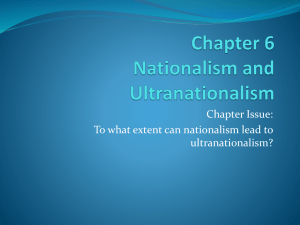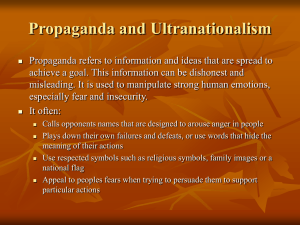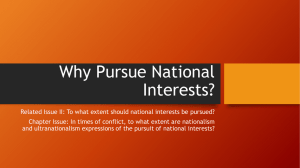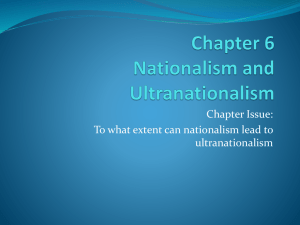Nationalism & Ultranationalism Worksheet: Treaty of Versailles
advertisement
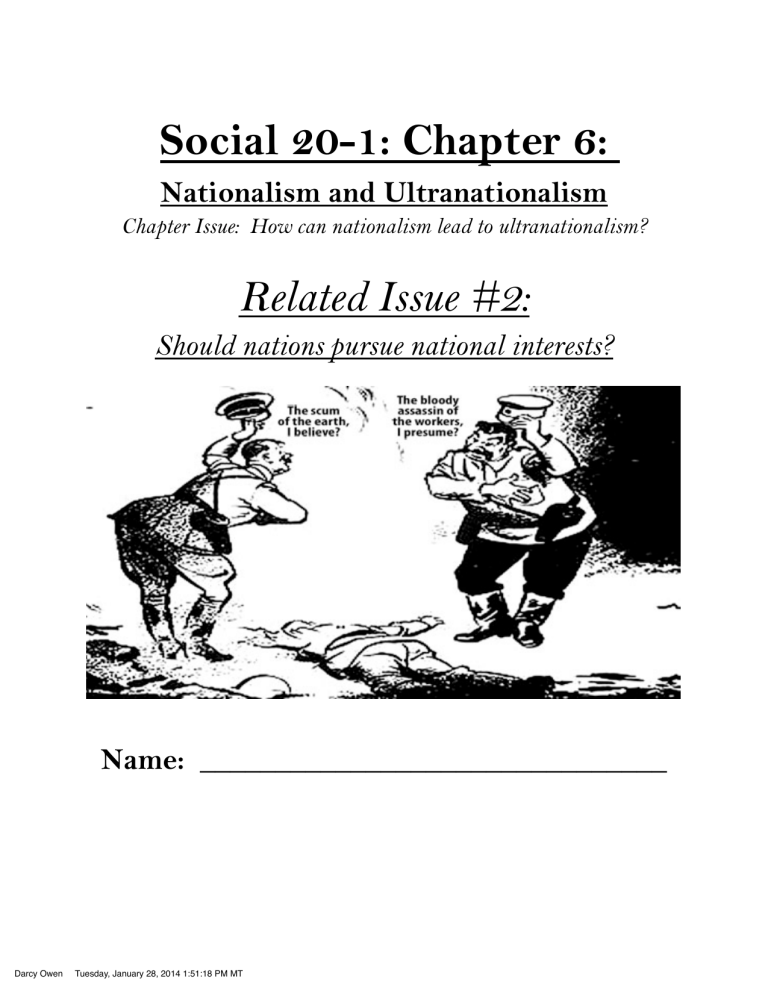
Social 20-1: Chapter 6: Nationalism and Ultranationalism Chapter Issue: How can nationalism lead to ultranationalism? Related Issue #2: Should nations pursue national interests? Name: _______________________________ Darcy Owen Tuesday, January 28, 2014 1:51:18 PM MT Area of Concern Option 1 Germany Blame-­‐ who is to blame for the war? Cost of the War £2,000,000 Germany must pay, but how much? Reduced to 100,000 men. German Military Option 2 Option 3 No one nation can be blamed Other (specify) £6,600,000, £24,000,000 Reduced to 250,000 men. No further conscription, though forces to remain as before the war. All armed services to be at pre-­‐ war levels. German Navy reduced to 36 German Navy reduced to ships. No conscription 50 ships. No conscription allowed. No tanks, allowed. Allowed to keep submarines, or aircraft to be all tanks, submarines, and built. All wartime weapons to air force. be melted down. Rhineland The Allies take control of the area not allowing the The area that lies on the German military to have a German side of the border presence in the area. to France Alsace-­‐Lorraine Returned to France Once part of France, was taken by the Germans in 1870 Given to France for 15 years. Saar An area of Germany with excellent coal @ields Allow the Germans some control of the area with Allied supervision under the control of the League of Nations Germany allowed to keep Placed under the control of it the League of Nations until a decision is made Remain in Germany-­‐ the Let Germany keep it-­‐ but The French need the rich coalOields are needed half of any proOit from the coalmines to rebuild after to build the Germany Oield must be given to the WW1. Following this time the economy after war Allies as war damages. people of Saar vote to see if they want to be French or German Finland, Lithuania, To become independent Latvia, and Estonia nations These were formerly part of Russia Czechoslovakia Place under international Formerly part of the control until a decision is Austro-­‐Hungarian Empire-­‐ made to satisfy all the empire broke up residents of the area. Darcy Owen The League of Nations occupies the area so no one nation has it under control. Tuesday, January 28, 2014 1:51:18 PM MT Placed under international Unite them under one control until a reasonable government decision that will satisfy all residents of the nations Make an independent Other (specify) nation Social 20-­‐1 Treaty of Versailles-­‐ Answer Sheet Area of Concern Option Reason Blame – who was to blame for the war? Cost of war-­‐ how much should Germany pay? German military Rhineland The area that lies on the German side of the border with France Alsace-­‐Lorraine Once part of France, taken by Germany in 1870 Saar-­‐ An area of Germany with excellent coal Oields Finland, Lithuania, Latvia, Estonia Czechoslovakia Formerly part of the Austro-­‐Hungarian Empire-­‐ the empire broke up Darcy Owen Tuesday, January 28, 2014 1:51:18 PM MT Chapter 6: Nationalism and Ultranationalism Related Issue #2: Should nations pursue national interests? Chapter Issue: To what extent can nationalism lead to ultranationalism? Examine the photos on page 136 and read the excerpt on page 137. We will discuss the questions on page 137 together as a class. What is ULTRANATIONALISM? (PAGES 138-140) Even when people do not agree on what NATIONALISM is, some say that it is the most powerful political force in the world. Some people also believe that ultranationalism - an extreme form of nationalism - is one of the most destructive forces in the world. ULTRANATIONALISM: Write out 5 points from page 138 below. Ultranationalists have a strong sense of their own national identity but little respect for the national identity of others. They may believe that their own nation-state can do NO wrong, even when it denies the human rights of some people. Some historians believe, for example, that the treaties that gave Britain and France control over the Middle East following World War I are examples of ultranationalism. Those treaties made sure that the peoples of the Middle East did not enjoy the same rights as citizens of Britain and France. Ultranationalists often separate people into “us” and “them”. In Turkey, read about the story of Hrant Dink, a Turkish journalist who was murdered because he wrote about the massacre of the Armenian people in 1915 in Turkey. Hrant Dink angered many Turks as many felt he publicly insulted the Turkish people. Ultranationalist often promote their own national interests - while ignoring or trampling on the national interests of other people within their own country and in other countries. This exaggerated sense of national interest, or ultranationalism, can even inspire them to invade and take over other countries. Darcy Owen Tuesday, January 28, 2014 1:51:18 PM MT From Nationalism to Ultranationalism Many people agree that ultranationalism includes elements of racism and fanaticism and that it can lead to conflict. But people do not always draw the line between nationalism and ultranationalism in the same place. Whether people call a particular policy nationalistic or ultranationalistic often depends on the nation they identify with. Some might say that the actions of people in their own group are patriotic but claim that similar actions by peoples in other groups are ultranationalistic. Building a strong military, for example, may be viewed as nationalistic in your own country but ultranationalistic in another country, especially if the country threatens your country's national security. Propaganda and Ultranationalism (Page 140) Propaganda refers to information and ideas that are spread to achieve a specific goal. The information and ideas are often misleading and may be dishonest. Ultranationalist often use propaganda to manipulate strong human emotions - especially fear and insecurity - and persuade people to behave in certain ways. We will examine the ideas of ultranationalism on pages 139, 140, and 141. Ultranationalism under Stalin in the former Soviet Union is covered on page 139 and 140. Ultranationalism under Hitler in Nazi Germany is covered on page 140 and 141. Please complete the chart on the next page in point form to help you understand what ultranationalism is and how ultranationalism develops. Please write down the 3 other points of propaganda below from the right margin on page 140: * spreading carefully selected information, rumours, and ideas Soviet communist government and Hitler's Nazi fascist government used propaganda to benefit their leadership over the people in the 1930’s and 1940’s. Joseph Goebbels, Adolph Hitler’s minister for public enlightenment and propaganda, built a huge propaganda organization to control all forms of the media. Goebbels used this propaganda machine to feed Germans‘ fears and insecurities and to deceive the German people into believing that they were SUPERIOR and Jews were EVIL. Darcy Owen Tuesday, January 28, 2014 1:51:18 PM MT Ultranationalism under Stalin and Hitler Ultranationalism in Russia under Stalin Darcy Owen Tuesday, January 28, 2014 1:51:18 PM MT Ultranationalism in Germany under Hitler How does ULTRANATIONALISM develop? (pages 141-148) Various factors and events can combine to transform nationalism into ultranationalism. An economic crisis, for example, can cause people to focus on their own needs and national interests. Sometimes a leader appears who can inspire people to follow and who is powerful enough to take control of an entire country. Leaders like this often use national symbols and myths to convince people that they are superior to the people of other nations. ***Factors that contribute to the development of ultranationalism:*** *a social or economic crisis* *a charismatic, powerful leader* *national symbols and myths that promote feelings of superiority* Countries in Crisis Please look at Figure 6-9 in the left margin on page 136. On October 29, 1929, the price of stocks on the New York Stock Exchange dropped. The result of this stock market crash had dramatic effects on the American economy and on the rest of the world. Charismatic Leaders During the 1920’s and 1930’s, ultranationalist dictators emerged in the Soviet Union (Stalin), Italy (Mussolini), Germany (Hitler), Spain (Franco) and Japan (Hirohito). These leaders were CHARISMATIC. They inspired enthusiasm and devotion in their followers - and FEAR in people who questioned their leadership or policies. They used deadly force to put down opposition. Instilling Ultranationalistic Values The dictatorhips in the Soviet Union, Germany, Italy, and Japan promoted extreme nationalist values. Domestic and foreign policies promoted these values, and strong military and police forces were built to protect them. Education was used to instil these values in children. Culture and art were also used to serve the ultranationalists’ goals and DROWN OUT opposing voices. Darcy Owen Tuesday, January 28, 2014 1:51:18 PM MT Germany: Factors that Contribute to the Development of Ultranationalism Examples Examples •extreme inflation in Germany •German money became worthless •Great Depression began 1929 •German workers faced homelessness and starvation •German gov’t trying to pay off reparation payments •Germany deeply in debt to USA •Germans looked for a strong leader to fix the country • Hitler began to gain support, told the Germans who was to blame for their problems and how they could fix them • Hitler appealed to the rich because Hitler would keep them rich if they followed Nazi rules • Hitler appealed to the working class because he would get them their jobs back • Hitler elected in 1933 A social or economic crisis Charismatic, powerful leaders Factors That Can Contribute to Ultranationalism National symbols and myths that promote feelings of superiority Examples *Nazi propaganda experts used radio, movies, public address systems and giant posters to keep Hitler’s image and message before the public *Nazis issued carefully planned news releases and photographs to the media *Nazi party members organized mass meetings that attracted audiences over 100,000 *Culture and art were used to serve the ultranationalist’s goals and drown out opposing voices *glorified the old German operas of Wagner that represented a glorified time of the past *Nazis introduced racist policies to eliminate anyone that was deemed inferior, including Jews, Roma, homosexuals, people with disabilities *anyone who challenged Nazi rule was eliminated *marriage and eventually friendship between Jews and non-Jews was forbidden *children and university students were taught Nazi values and any teachers that opposed these Nazi values were eliminated *schools burned books that were against an un-German spirit Darcy Owen Tuesday, January 28, 2014 1:51:18 PM MT Recognizing Propaganda Type of item (e.g., speech, poster) Audience (e.g., Canadian voters) Purpose (e.g., the action the piece is promoting) Question Answer (Yes or No) If yes, how does it do this? Does the message resort to name calling? Does the message appeal to people’s anger or fears? Does the message use words that hide the true meaning of actions? Does the message use respected symbols to appeal to people’s values and beliefs? Does the message use fear to encourage support? I conclude that this item is or is not propaganda because..... Darcy Owen Tuesday, January 28, 2014 1:51:18 PM MT Japan after World War I Please look at Figure 6-11in the right margin on page 137 about Japan’s emperor, Hirohito. We will examine the development of ultranationalism in Japan now. During World War I, Japan had supported the Allies. After the war, Japanese agriculutural and industrial exports to Europe and the United States increased. But, when the Great Depression started, these trading partners tried to support their own industries by limiting imports - and people back in Japan lost their jobs. Questions (page 144): 1. What happened in 1932 in Japan? 2. Who did Japanese ultranationalists blame for the crisis? 3. What did Japanese ultranationalists get even angrier about next? 4. Who did Japan invade in 1931? 5. Why did Japan invade this territory in 1931? 6. Where is this territory located? 7. What did Japan look like by 1937 and who were they at war with? 8. What did military leaders bring back to Japan? 9. What was created around emperor Hirohito? Darcy Owen Tuesday, January 28, 2014 1:51:18 PM MT “Hirohito and Tojo” Questions (page 145): 1. What did Japanese ultranationalists work to do in the years before World War II? 2. What is an example of Japanese foreign policy under the leadership of the military? 3. What two things did the Japanese leaders want? 4. How did they justify their territorial expansion to their people? 5. Who became prime minister in 1941 in Japan and what did he do? 6. How would you describe this General and what did he promise the Japanese people? “Ultranationalist values in Japan” Questions (page 148): 1. How were Japanese and Nazi ultranationalism similiar? 2. What beliefs and values were fostered by the Japanese leaders leading up to World War II? 3. What was the Japanese government’s “foreign policy” doing while ultranationalist were taking over the “domestic” affairs of Japan? Darcy Owen Tuesday, January 28, 2014 1:51:18 PM MT 4. What 3 things were students in Japan taught in the 1930’s? 5. Whose ideas were scorned by Japan and whose ideas were praised in the 1930’s? 6. What were priorities in Japan and what did these include? 7. Who were honoured in Japan under this regime? 8. What is Japan’s national religion called and what does this religioin teach? 9. Who is honoured in this religion? 10. Who are the Kami? 11. Why is the Shinto Yasukuni Shrine in Tokyo, Japan controversial? 12. What do some Japanese people want today concerning the shrine? Darcy Owen Tuesday, January 28, 2014 1:51:18 PM MT Japan: Factors that Contribute to the Development of Ultranationalism Examples Examples • Many Japanese lost their jobs during Great Depression because USA/Europe reduced Japanese exports •Japanese produced silk but many people around the world could not afford luxury item – many lost their jobs in Japan - blamed the West • rice crops failed in 1932 – caused famine in Japan • Japanese ultranationalists blamed their politicians for the famine crisis-need to turn to new leadership in Japan • Japanese got mad at USA, Canada, Australia for not accepting Japanese migrants • Japan invaded Manchuria in 1931 •By 1937, military controlled Japanese gov’t and at war with China •Military leaders brought back traditional warrior values such as obedience to the emperor and state *a cult-like atmosphere was created around emperor Hirohito A social or economic crisis Charismatic, powerful leaders Factors That Can Contribute to Ultranationalism National symbols and myths that promote feelings of superiority Examples * ultranationalists worked to rid Japan of democracy and make it a one party state ruled by military * commander’s of Japan’s armed forces decided was in the country’s national interest * Japan invaded China for raw materials to continue to increase industrialization in Japan-justified their expansion into China because they saw USA and European colonies doing same thing since the early 1800’s * General Tojo Hideki became prime minister in 1941 and transformed Japan into a military dictatorship; Tojo was an aggressive ultranationalist who promised Japan would use its military to dominate Asia * ultranationalists in Japan were preparing the nation for war and fostering racist beliefs in Japan by convincing the Japanese people that they were superior to other people and had a mission to expand Darcy Owen Tuesday, January 28, 2014 1:51:18 PM MT How have people responded to ULTRANATIONALISM? (pages 149-154) Ultranationalism infects all aspects of a country's life - social, economic, cultural, and political. Ultranationalists often believe that they have the right to invade other countries and take over territory by force. When this has happened, national leaders around the world have found it difficult to find peaceful ways to respond. Please read Martin Neimoeller's words in Voices in the right hand margin on page 149. Discuss the following questions: ο What is he saying about why some people failed to take action? ο Why might people have failed to speak up? ο In a similar situation, what might make you speak up? ο How might people who failed to take action feel when they found about the Holocaust? The failure to act is one response to ultranationalism. Sometimes fear, apathy, or ignorance can lead people to respond to ultranationalism by doing nothing. Advantage: You may be able to remain invisible and therefore safe. Disdvantage: Others may suffer and feel abandoned by their friends and neighbours. Here is a List of the Items We Will Cover in This Next Section: 1. Appeasement i) Opposition to Appeasement ii) Failure of the League of Nations iii) Ethiopia 2. War as a Response to Ultranationalism i) Total War ii) Propaganda and Censorship in Canada iii) Conscription in Canada 3. Internment Camps in Canada i) Ukrainian Canadians in World War I ii) Japanese Canadians in World War II 4. Peacekeeping as a Response to Ultranationalism i) Suez Canal Crisis Darcy Owen Tuesday, January 28, 2014 1:51:18 PM MT Appeasement as a Response to Ultranationalism (page 149) Questions: 1. Why did people wish to avoid war in the years before World War II? Darcy Owen 2. Who began to take over other countries and territory in Europe? 3. What is appeasement? 4. When did Germany begin expanding its European territory? 5. In 1938, who was British prime minister? 6. In 1938, who was French prime minister? 7. In 1938, who was Italian dictator? 8. What was Germany's land claim and where is it located? 9. Why was their conflict over this region? 10. What did Hitler promise at this meeting? 11. What did the British, French, and Italians promise in return? Tuesday, January 28, 2014 1:51:18 PM MT 12. What did Chamberlain say to the British people to make them feel more secure? Opposition to Appeasement (page 149) 1. Who did not agree with the philosophy in Britain? Darcy Owen 2. Who was Winston Churchill? 3. Who was prime minister of Britain during World War II? 4. What was Churchill's comment about an appeaser? 5. What did Churchill say about the choice made by Chamberlain, Deladier, and Mussolini? 6. What happened in 1939? 7. Look at the map on page 149 Figure 6-15 and identify the territories that Germany took over between 1935 and 1938. 8. In 1938, when Germany took over the Sudetenland, would you have agreed with Neville Chamberlain's or Winston Churchill's response? Explain why. Tuesday, January 28, 2014 1:51:18 PM MT Failure of the League of Nations (page 150) By 1934, 58 countries, including Canada, Britain, and France, were members of the League of Nations, which had been created after World War I. League members agreed to help one another and to take action to maintain peace. If one country invaded another country, League members could: * * * But member countries were not required to provide troops to stop invasions. When Japan invaded Manchuria in 1931, for example, China appealed to the League for help. The League condemned the invasion. Japan responded by resigning its membership in 1933. After that, League members COULD NOT agree on what action to take - and ended up doing nothing. Ethiopia 1. What did Italy suffer following World War I? Darcy Owen 2. Who was appointed prime minister of Italy in 1922? 3. What did he promise to do? 4. Who was Mussolini and what did he do “politically-speaking” to Italy for himsef ? 5. How was Mussolini's like Hitler and Stalin? 6. What did his policies include? Tuesday, January 28, 2014 1:51:18 PM MT 7. Why did Italy expect to be rewarded following World War I? 8. Why were ultranationalists’ angry in Italy after World War I? 10. What did Mussolini order in 1935? 11. What was the irony of Mussolini's order? 12. Who is Haile Selassie? 13. What did Selassie do in June 1936? 14. What did Selassie say in his speech to the League of Nations in 1936? More to the story: On August 23, 1939, Germany and the Soviet Union signed the Nazi-Soviet Non-aggression Pact. This treaty assured Hitler that his armies would not have to fight on two fronts when Germany began taking over Europe. The world was shocked at a pact between fascist and communist governments - such a development seemed unbelievable. Seven days later, Germany invaded Poland. Darcy Owen Tuesday, January 28, 2014 1:51:18 PM MT War as a Response to Ultranationalism (pages 143-145) On September 1, 1939, Hitler's armies invaded Poland. Thousands of tanks and 1.5 million soldiers attacked by land while German airplanes bombed Polish cities. German blitzkrieg had begun. The Polish army was no match for highly trained and well-equipped German forces. Poland surrendered to the invaders within four weeks. Total War and Canada Declares War (page 151) Canada entered World War II far different from how they entered World War I. By 1939, Canada’s foreign policy was no longer tied to that of Great Britain’s, like it had been in 1914. This meant Canada did not declare war on Germany as soon as Britain did. The Canadian government debated the merits of entering the war, and one week later after the formal declaration of war by Great Britain, Canada declared war on Germany - September 10th, 1939. Prime Minister William Lyon Mackenzie King used an emotional and difficult speach on the radio to inform all Canadians at the time the decision of the Canadian government and the reasons as to why that decision had been made. His speach is on the bottom of page 143. Total War: Propaganda and Censorship in Canada (page 151) Canada entered World War II and Canada's national interest now focused on the war effort. Canadians were encouraged to support the war effort by joining the armed forces, working in wartime industries, or volunteering to help in other ways. The Canadian government, however, began to adopt features used in dictatorships. Propaganda campaigns were launched to recruit soldiers and persuade Canadians to buy war bonds. No employer was allowed to hire anyone who did not have a permit from an employment office, and employment could be restricted to specific locations or industries considered essential to the war effort. Official censorship was introduced to ensure that no essential information fell into the hands of the enemy. Government censors approved every speach broadcast on the CBC and examined all stories published in all newspapers and magazines. Military censors read all letters from members of the armed forces as well as letters to soldiers in enemy prisoner of war camps. Anything that revealed to much was blacked out. Examine the Wartime Propaganda posters on pages 151 and 152. After you have read page 151, 152 and 153 answer the following question: By introducing propaganda and official censorship, tactics that are also used in dictatorships, was the Canadian government starting down the path to ultranationalism? What do you think? Yes or no! Discussion!!! Darcy Owen Tuesday, January 28, 2014 1:51:18 PM MT Conscription in Canada (page 153) To the leaders of Germany, Italy, Japan, and the Soviet Union, conscription - compulsory military service - was in the national interest. A strong military was essential to secure their own borders and to invade other countries. In dictatorships, it is not hard to force people to become soldiers. When World War II started, the Canadian Armed Forces were made up entirely of volunteers. Soon after the war began, Prime Minister William Lyon Mackenzie King introduced a limited form of conscription. But he promised that conscripts would be asked only to defend Canada. They would not be sent overseas. King did not want to repeat the turmoil - including protests and riots - that had occurred when conscription was introduced during World War I. In 1917, the government had imposed conscription after the Allies had suffered severe losses. The issue divided Canada during World War I and was set again to divide Canada during World War II. Many Canadians of British descent believed that conscription was in the national interest, but others disagreed. Some worried about what would happen to their families and farms. Many Francophones did not believe that they should be forced to fight for the British Empire. Still, Francophones had volunteered at about the same rate as Anglophones. As casualties mounted during World War II, King decided to hold a special vote to ask Canadians' permission to break his promise not to send conscripts overseas. Internment Camps in Canada (pages 152-153) During World War I and World War II, many Canadians became caught up in the racism and extreme nationalism of the time. Thousands of people of German, Ukrainian, and Japanese origin were interned - sent to prison camps - as enemy aliens. Darcy Owen Tuesday, January 28, 2014 1:51:18 PM MT “Peacekeeping” as a Response to Ultranationalism (page 148) Questions: 1. Why was the United Nations formed? 2. What did UN missions involve at first? 3. What happened in 1956? 4. What does the Suez Canal link and when was it built? 5. What benefit did the Suez Canal have for the people of the world? 6. What continent did ships no longer need to travel around? 7. What did ships pay to get through the canal and where did the profits go? 8. Who owned the Suez Canal in 1956? 9. Why did the Egyptian government take control of the canal in 1956? 10. Looking at the map in Figure 6-28, do you think the Egyptian government might have felt entitled to take over the Suez Canal? 11. Do you believe Egypt's actions in 1956 were nationalistic or ultranationalistic? Explain your answer. 12. Darcy Owen Who invaded the Suez Canal zone in response to Egyptian actions? Tuesday, January 28, 2014 1:51:18 PM MT 13. Which country supported Egypt and what did they threaten to do? 14. What was the result of this in regards to the rest of the world? 15. What was Lester B. Pearson's role at the time in Canadian politics in 1956? 16. What did Pearson propose to help diffuse the situation in Egypt? 17. How did the UN respond to Pearson's suggestion? 18. What was the result? 19. What did this event start? 20. What does the Canadian governments believe and how does it relate to our foreign policy? 21. By 2007, how many peacekeeping missions had Canada taken part in? Darcy Owen Tuesday, January 28, 2014 1:51:18 PM MT Present an Example of Propaganda You will create a poster, a political cartoon, a slogan, or some other example of propaganda! As you complete this activity, remember to use respectful images and words. Focus your propaganda piece on a positive aspect of national interest, such as support for the country’s war effort or helping newcomers to the country. …. TO MAKE A POSTER Step 1: Decide on the message Review the ideas explored in class on nationalism and propaganda. Jot down ideas that you think would provide effective content for a propaganda message. Step 2: Decide on the format Decide on the format of the propaganda message.You may choose a cartoon, a poster, a drawing, a slogan, or some other format. The format you choose will strongly influence the message you create. A poster, for example, requires fewer words but a strong image. A political cartoon requires a clever symbol or scenario, and a slogan must be short, catchy, and easily remembered. Questions like the following may help you decide which format will work most effectively: • Which format would communicate my message most effectively? • Do the format and the message work together effectively? • Does the format enable me to communicate the bias I want to show? • Will this format appeal to my target audience? Darcy Owen Tuesday, January 28, 2014 1:51:18 PM MT Step 3: Prepare a first draft Create a rough sketch of the piece. Write the words that will appear on your poster, or the caption that will go with your political cartoon, or the first draft of your slogan, or the text needed for the format you have chosen. Ask a classmate or me for feedback. Revise your work to reflect the feedback you receive. Step 4: Write the display card Complete the display card that will accompany your propaganda piece. On it, explain the purpose of your piece and the bias you have built into it. Step 5: Finish your propaganda piece On the basis of the changes you made to your first draft, complete your propaganda piece. Store it in a safe place until you are ready to hand it in in class! Adapted from: http://www.mcgrawhill.ca/school/secondary/undernationalism/docs/UN_se_Ch06.pdf Darcy Owen Tuesday, January 28, 2014 1:51:18 PM MT

